ArcGIS GeoPlanner dashboards display Scenario Indicator, Baseline Indicator, and Chart Indicator information in gauges, numeric values, and charts so you can quickly visualize and understand the effects of design decisions in real time. A dashboard displays qualitative and quantitative information about your design layer or data layer point, line, and polygon features. As you add, update, and delete features in your design layers, the dashboard automatically updates indicators to provide immediate feedback on the effects of your design decisions. Baseline Indicators connected to data layers must be manually recalculated before their impact can be assessed with the dashboard.
The GeoPlanner dashboard allows you to track impact across multiple indicators so you can easily assess advantages and disadvantages while balancing multiple competing priorities for your design outcome. These indicators can be represented as charts, numerical values, or gauges in the dashboard. Charts provide qualitative indicators of a plan's performance. Numerical values and gauges provide a quantitative indication of a plan's performance. Once a collection of charts, numerical values, and gauges has been defined for measuring the performance of designs in a planning project, its configuration can be shared with other project team members as a way to standardize the parameters used for evaluating alternatives among the team.
You can configure multiple charts, numerical values, and gauges in a dashboard so that you can monitor several different indicators. You can also modify indicators with data layer features using baseline modifiers. You can share a dashboard with your project team members or the template that was used to create your project. Sharing a project created from a specific template or any indicators used in a project helps standardize the indicators and saves time by reducing configuration.
You can open the dashboard by clicking the Dashboard button  on the map.
on the map.
There are three types of dashboard items: charts, numerical values, and gauges.
Charts
Charts help you understand the distribution of feature types in a dataset and, optionally, can be configured to show a qualitative indication of suitability for your plans. Each dashboard chart in GeoPlanner displays two graphics: primary and secondary charts. The primary chart displays the distribution of unique feature types for the selected layer. The secondary chart displays a summary of features from an assessment layer or evaluation model related to the features highlighted in the primary chart.
The following image represents a dashboard chart that contains a primary chart of design layer land-use polygon features and a secondary chart of an assessment layer of neighborhood home values. The yellow pie wedge represents residential features in this plan. The secondary chart summarizes the types of neighborhood home value features in those residential features.
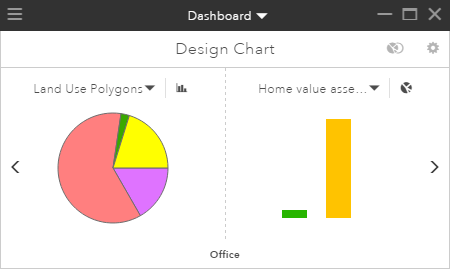
Primary charts can help answer questions such as the following:
- How many hectares of residential land are in my design?
- What is the total length of highways in my transportation plan?
- How many wells are in an area of interest?
Secondary charts show how design layers overlay with an assessment or evaluation model layer. They can help answer questions such as the following:
- How much of my proposed residential land is within a five-minute walk to a park?
- How much of my proposed highway expansion is inside of an area of low population density?
- How many of my wells are located inside of a 100-year flood plain of a river or stream?
Charts are dynamic. They update each time you create, modify, or delete features in your design layers.
Assessment layers and evaluation models
Assessment or evaluation model layers help you understand the suitability of a development activity in an area. These layers increase your spatial awareness so you can plan and design more effectively in a given geographic context. They are used in the secondary charts to display a relationship to the features in the primary chart.
Assessment layers are created using one of the following methods:
- Run an analysis tool from the Analysis drop-down menu on the Explore tab, and reclassify the result layer using the classify function.
- Reclassify any feature layer using the classify function.
Evaluation models are the output from weighted raster overlay.
Numerical values
Numerical values allow you to analyze your features quantitatively. Numerical values on your dashboard are based on Scenario Indicator and Baseline Indicator values. You can use these values to show raw counts of your data, averages, standard deviations, and more.
Numerical values can help you answer questions such as the following:
- What is the population inside of the boundaries of my design area?
- What is the average area of all land-use layers in my scenario?
- What is the population density of rare butterflies in a habitat, normalized by the total population of rare butterflies in my dataset?
Gauges
Gauges help you understand the effect or outcome of your designs relative to a specific, calculated performance metric. Gauges allow you to define ranges and targets appropriate to specific indicators you want to evaluate your plans against. With indicators, the value presented on the gauge is calculated in real time using an equation consisting of feature type filters, feature attribute values, constants, and arithmetic operators that you define specific to your indicators. Gauges created with Baseline Indicators must be manually recalculated for their results to show.
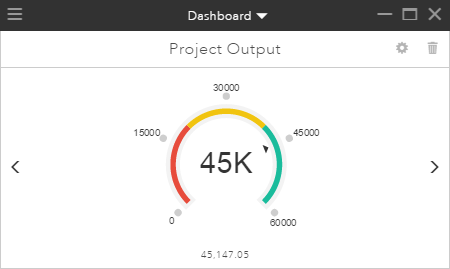
Gauges help you answer questions such as the following:
- What is the projected population of a housing development?
- What is the projected yield of a crop in an area of interest?
- How many jobs could be created from a new commercial development?
Study areas
Study areas represent planning subareas. Study areas help you focus on a specific location such as a neighborhood or a watershed. When you activate a study area, the dashboard computes metrics for scenario features that are inside of or that intersect that study area.
Nondesign layers
You can set nondesign layers in the primary chart of the dashboard. These layers must be polygon feature layers with a unique value renderer. Dashboard charts configured with nondesign layers in the primary chart only report on visible features.
Reorganizing dashboard items
You can reorganize dashboard items by clicking and dragging them. All dashboard items, regardless of their type, can be rearranged this way.
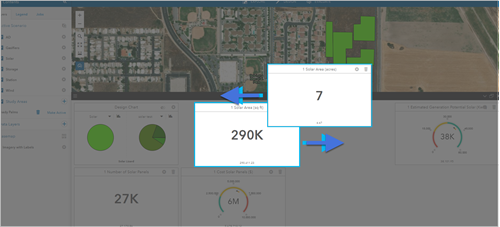
Maximize the dashboard
The GeoPlanner Dashboard allows you to view a single chart or gauge item at a time, or you can view the entire dashboard simultaneously:
- Maximize button—Increases the size of the dashboard to the maximum allowed by your screen resolution so that you can view the values of many or all of your dashboard items at once.
- Restore button—Returns the dashboard to its default size, where a single dashboard item is displayed.
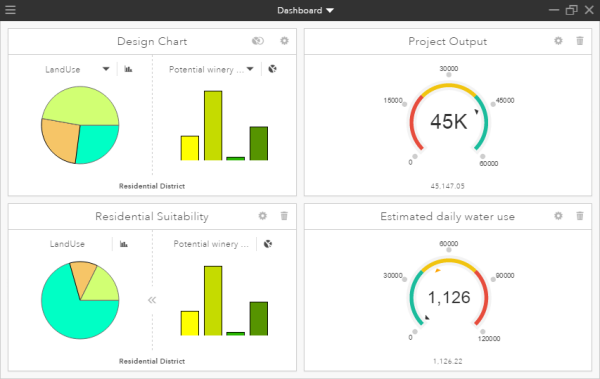
Note:
When maximizing the dashboard, you can hide other interface elements so that all charts and gauges can be seen clearly without obstruction.
Display metrics for selected features
You can review metrics for a subset of features when you display the dashboard while you select multiple features from a scenario layer by completing the following steps:
- In a GeoPlanner project, open the dashboard by clicking the Dashboard button
 on the map.
on the map. - Click the Design tab and choose the Multi-Select tool.
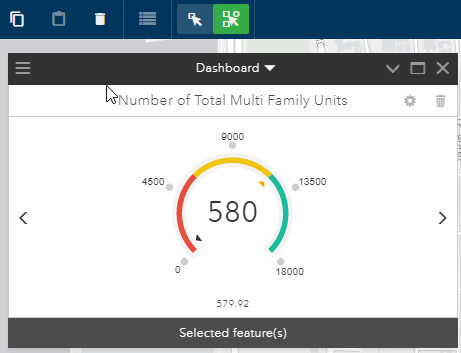
The Multi-select pane appears.
- Click the Layer drop-down arrow and choose the scenario design layer from which you want to choose features.
- Click the Selection Tool drop-down options and choose New set.
- Choose the Rectangle tool.
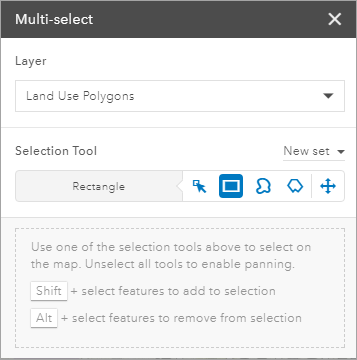
- On the map, draw a rectangle around the features you want to select.
The dashboard metrics change to reflect the features you have selected.
Specify dashboard settings
You can specify how features are included in dashboard items in the Dashboard Settings window by completing the following steps:
- On the dashboard, click the Dashboard Options button
 .
. - Click Dashboard Settings.
The Dashboard Settings window appears.
- In the Gauges section, choose one of the following options to configure how gauges show data on your dashboard:
- Visible Features—Gauges on the dashboard only load if the features they represent are visible on the map. Choosing this option can improve your project's performance.
- All Features—Gauges on the dashboard load for all features in the scenario.
- In the Charts section, choose one of the following options to configure how charts show data on your dashboard:
- Visible Features—Charts on the dashboard only load if the features they represent are visible on the map. Choosing this option can improve your project's performance.
- All Features—Charts on the dashboard load for all features in the scenario.
- In the Optimize Performance for section, adjust the slider between the Speed and Accuracy values to change your project's performance.
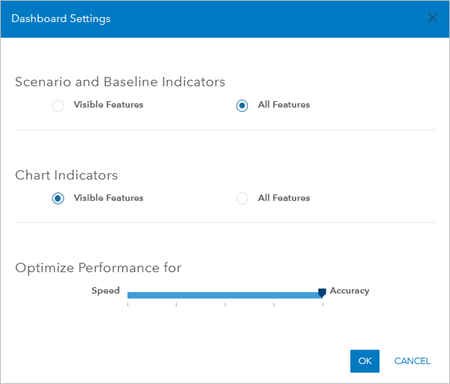
Note:
This slider controls how a feature is generalized when retrieved from your ArcGIS organization and included in a dashboard calculation. Generalization is the process of simplifying features for a change of scale or resolution. The slider represents a maximum offset tolerance. Vertices in that tolerance are hidden so that the features displayed on the map contain a subset of the original feature vertices.
When the slider is set to Accuracy, no generalization occurs. Area, perimeter, and length calculations in charts and gauges are accurate. As you move the slider toward Speed, your features are more generalized. This reduces the accuracy of area, perimeter, and length calculations in charts and gauges.
Consider moving the Optimize Performance slider to greater generalization tolerances when working at regional, national, or global scales.